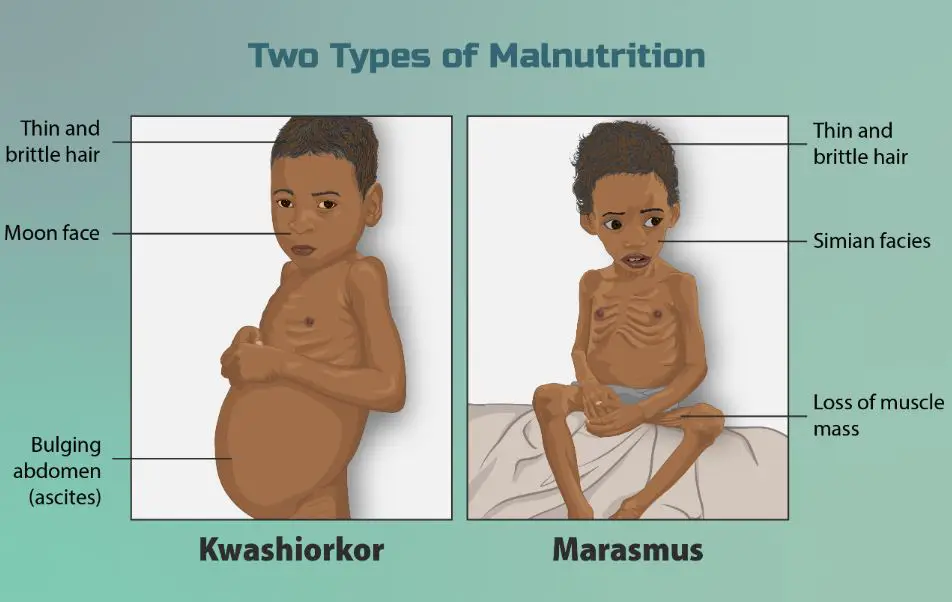Table of Contents
Malnutrition in India its types, causes and effects | UPSC – IAS
Malnutrition refers to any deficiency, excess, or imbalance in an individual’s intake of energy and nutrients. It encompasses a wide range of conditions caused by inadequate or excessive consumption of food and nutrients. The issue of malnutrition is particularly severe in India, impacting millions and hindering the nation’s progress.
Types of Malnutrition | UPSC – IAS
Malnutrition can be categorized into two primary types:
Undernutrition
- Stunting: Low height for age.
- Wasting: Low weight for height.
- Underweight: Low weight for age.
- Micronutrient deficiencies: Insufficient levels of essential vitamins and minerals.
Overnutrition
- Overweight and Obesity: Excessive weight due to high caloric intake.
- Diet-related non-communicable diseases: Includes conditions such as cardiovascular disease, hypertension, type-2 diabetes, and certain cancers.
Specific Types of Malnutrition
- Marasmus: A severe form of malnutrition caused by insufficient intake of protein, calories, and other nutrients, often due to poverty.
- Kwashiorkor: Severe protein deficiency characterized by edema and an enlarged liver, common in children.
Fundamental Causes of Malnutrition in India | UPSC – IAS
The causes of malnutrition are multifaceted and deeply rooted in socioeconomic and systemic challenges:
Major Causes Includes:-
- Poverty: A primary cause of malnutrition, limiting access to adequate food and nutrition.
- Barriers to healthcare: High costs, inadequate insurance coverage, and lack of accessible services.
- Social factors: Early marriages, teenage pregnancies, and poor breastfeeding practices contribute to malnutrition in women and children.
- Lack of safe drinking water: Leads to poor digestion and waterborne diseases.
- Poor sanitation: Causes illnesses such as cholera and diarrhea, exacerbating malnutrition.
- Illiteracy: Particularly among women, impacting knowledge of nutrition and proper feeding practices.
Additional Factors are as follows:-
- Regional disparities and economic inequality.
- Limited awareness about nutritional needs, particularly for infants and young children.
Malnutrition in India | UPSC – IAS
Despite significant economic growth, India is home to more than one-third of the world’s malnourished children. Key statistics highlight the severity of the problem:
- Child malnutrition: Nearly half of children under three are underweight.
- Economic inequality: Leads to diets lacking both quality and quantity.
- Health impacts: Malnourished individuals face higher susceptibility to infectious diseases such as pneumonia and tuberculosis.
Effects of Malnutrition in India | UPSC – IAS
The consequences of malnutrition are severe and far-reaching:
Individual Impacts are:-
- Increased disease vulnerability: Undernutrition heightens the risk of infectious diseases like malaria and pneumonia.
- Developmental delays: Chronic malnutrition impairs physical and mental development in children.
- Low productivity: Childhood stunting can reduce adult productivity and economic contributions.
- Poor maternal health: Malnutrition increases pregnancy-related complications.
Societal Impacts:-
- Economic burden: Malnutrition escalates healthcare costs and slows economic growth.
- Impediment to development: Child undernutrition undermines India’s socioeconomic potential.
Steps Taken by the Government | UPSC – IAS
The Indian government has launched several initiatives to combat malnutrition:
Major Programs
- POSHAN Abhiyaan: Aims to improve nutritional outcomes for children, pregnant women, and lactating mothers.
- Anemia Mukt Bharat (AMB): Focuses on iron and folic acid supplementation.
- Integrated Child Development Scheme (ICDS): Provides health and nutritional support to children under six and their mothers.
- Public Distribution System (PDS): Ensures subsidized food grains for low-income households.
- Midday Meal Scheme: Offers nutritious meals to schoolchildren to enhance attendance and health.
Addressing the Challenges
Proposed Solutions are as follws:-
- Improve food systems: Encourage organic farming, mixed cropping, and food fortification to ensure nutrient-rich diets.
- Invest in women’s education: Reduce early marriages and improve maternal care.
- Strengthen health infrastructure: Enhance Anganwadi centers’ functionality and ensure access to healthcare.
- Community involvement: Promote awareness campaigns to address cultural barriers and nutritional gaps.
- Better governance: Ensure effective implementation of existing schemes through increased funding and monitoring.
Conclusion and Way Forward | UPSC – IAS
To combat malnutrition effectively, India must adopt a comprehensive and multisectoral approach. This includes:
- Strengthening existing programs such as POSHAN Abhiyaan and ICDS.
- Leveraging data for informed policy-making.
- Promoting dietary diversity and nutrient-rich food production.
- Ensuring community participation and local solutions.
Malnutrition is not just a health issue but a social and economic challenge. Eradicating it requires coordinated efforts from governments, communities, and international organizations to secure a healthier and more prosperous future.
FAQs
- What are the main causes of malnutrition in India? Poverty, lack of healthcare, poor sanitation, and social factors like early marriage.
- What are the types of malnutrition? Undernutrition (stunting, wasting) and overnutrition (obesity, diet-related diseases).
- How does malnutrition affect children? Causes developmental delays, increased disease vulnerability, and cognitive impairments.
- What is POSHAN Abhiyaan? A government initiative to enhance nutritional outcomes for children and mothers.
- How can malnutrition be reduced? By improving food security, enhancing healthcare, and promoting education and awareness.


